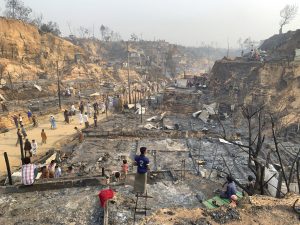At least 15 people have been killed by a blaze that tore through a Rohingya refugee camp in southern Bangladesh on Monday, destroying thousands of shelters and dwellings, local officials have reported.
According to media reports, firefighters took more than eight hours to subdue the fire, which broke out in the afternoon at the Balukhali camp outside Cox’s Bazar, and spread quickly due to high winds.
At least 400 people were still missing and around 560 were injured by the fire, according to Louise Donovan, a spokesperson for the United Nations’ refugee agency (UNHCR). “So far, the fire has affected shelters, health centers, distribution points and other facilities. Volunteers are supporting those affected,” Donovan said, according to Al Jazeera.
UNHCR said around 45,000 people were displaced by the fire, which broke out Monday afternoon and burned well into the night. Roughly 250 acres were burned, a government official said. Donovan added that humanitarian partners have mobilized hundreds of volunteers from nearby camps to support the efforts, as well as fire safety vehicles and equipment. Many of those displaced has since taken refuge in nearby camps, temporary transit sites, and learning centers.
The Danish Refugee Council said that the fire displaced 27,000 people, while the U.N. World Food Program reported that up to 87,855 people were affected. The International Federation of Red Cross and Red Crescent Societies estimated that 123,000 refugees in the camps were affected by the fire.
The widely varying figures speak to the sheer size and concentration of the refugee concentrations around Cox’s Bazar. The area is home to around 1 million Rohingya Muslims, many of whom were forced over the border by fierce assaults by Myanmar’s military in 2016 and 2017, acts which U.N. investigators claim showed “genocidal intent.”
The fire – the fifth so far this year in the Rohingya camps – was another cruel twist of fate for people who already been subject to unspeakable treatment at the hands of Myanmar’s security forces. “Everything we owned is now ash,” one man whose shelter was destroyed told the New York Times. “This is the second time I lost everything in my life.”
The disaster underscores the risks posed by the sprawling camps, and the urgency of resolving the humanitarian crisis. The government of Bangladesh is eager to begin sending the refugees back to Myanmar, but several attempts at repatriation have failed because many Rohingya refused to go, rightly fearing that they would be subject to more violence and discrimination. Several thousand have been resettled on an island in the Bay of Bengal, which the U.N. and rights groups fear lacks basic amenities and is vulnerable to cyclones.
The military’s February 1 coup has further complicated any resolution to the humanitarian crisis, pushing Myanmar into a political crisis that presently shows few signs of abating.
As the humanitarian group Refugees International said in a statement, “This tragedy is an awful reminder of the vulnerable position of Rohingya refugees who are caught between increasingly precarious conditions in Bangladesh and the reality of a homeland now ruled by the military responsible for the genocide that forced them to flee.”
As it stands, the Rohingya risk being forgotten in the general chaos that has followed the military’s seizure of power.

































